Xeriscaping has been termed as one of the solutions to drought. It’s considered one of the affordable landscape alternatives in place of lawns.
Although most people associate the term xeriscape with a desert or barren landscape, there’s a lot more to this landscape design that thrives with little to no water. You may find it includes using mulch, succulents, sands, and drought-resistant or xeric plants.
Our detailed guide lists some of the best xeriscape plants for Colorado.
Table of Contents
16 Best Xeriscape Plants for Colorado
Here’s a list of some xeriscape plants to consider.
1. Agastache

Agastache is a perennial herb common in northern Mexico and the southwestern U.S.
Also referred to as hummingbird mint, the herb has pink and orange flowers that attract hummingbirds. There’s also a variety of blue flowers that is a favorite of bees and butterflies.
The hardy plant thrives well in total sun exposure and well-drained soil.
Also, the ground needs to be infertile. Fertile soil encourages lush flower growth, it can also lead to damage over winter.
Avoid cutting back Agastache in the fall, which allows re-seeding and improves winter hardiness. The best time to cut the plant back is mid-spring. Its stems provide nutrients to protect the plant against the cold.
Agastache is best planted in a woodland garden as rabbits and deer don’t like it.
2. Agave
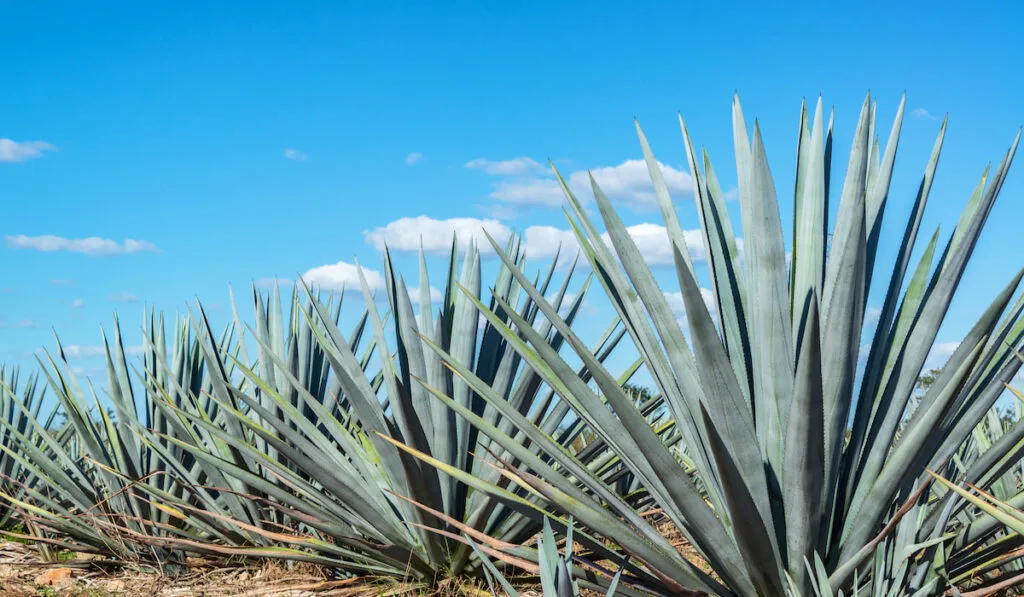
Agave is a perennial succulent with long leaves and spiny tips at the end. The plant is native to North America, even growing in Canada and the Pacific Northwest.
Being a drought-tolerant plant, agave is best planted in a mature arid garden. Early fall or spring is the best time to plant this succulent.
Growing agave requires soil with good drainage, full sun, and mild watering during the first few days. After the third week, you’ll only need to water the plant once a week.
It’s unnecessary to fertilize agave plants as this encourages flowering and can lead to the plant dying. You’ll notice that once flowers produce seed pods, the plant dies. That is a regular occurrence for most agave species.
Note that agave plants grow slowly. They can take years to mature.
3. Apache Plume
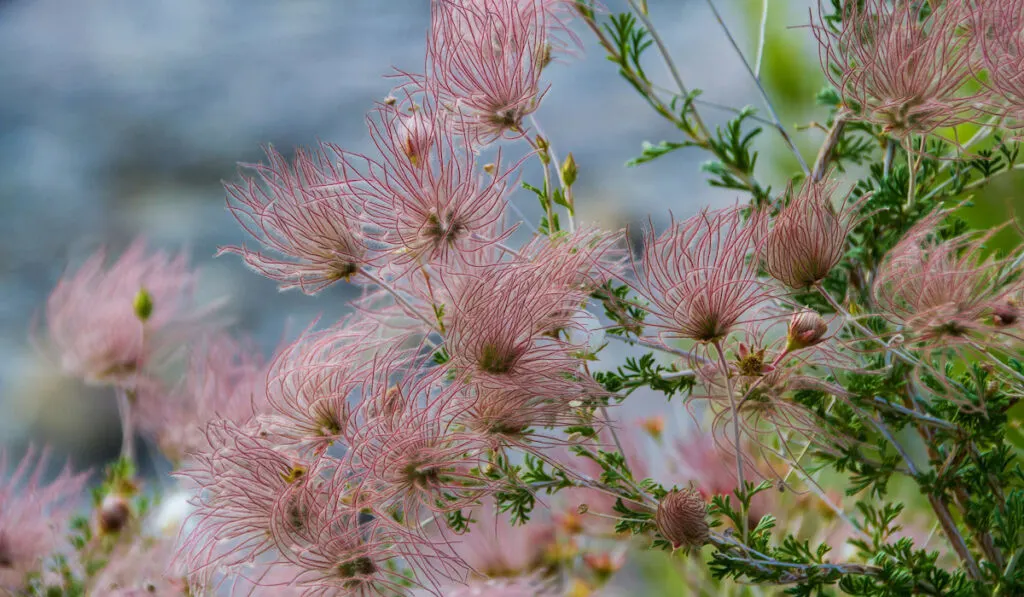
Apache plume is a native western shrub that blooms in spring and summer. The drought-resistant plant has single white flowers and fluffy pink seed heads.
Bees and butterflies love Apache plume, as its rich in nectar.
Its flowers also contrast nicely against the dark foliage.
The shrub can grow up to 6 feet tall and 5 feet wide. It performs best in dry, well-drained soil and full sun.
4. Artemisia
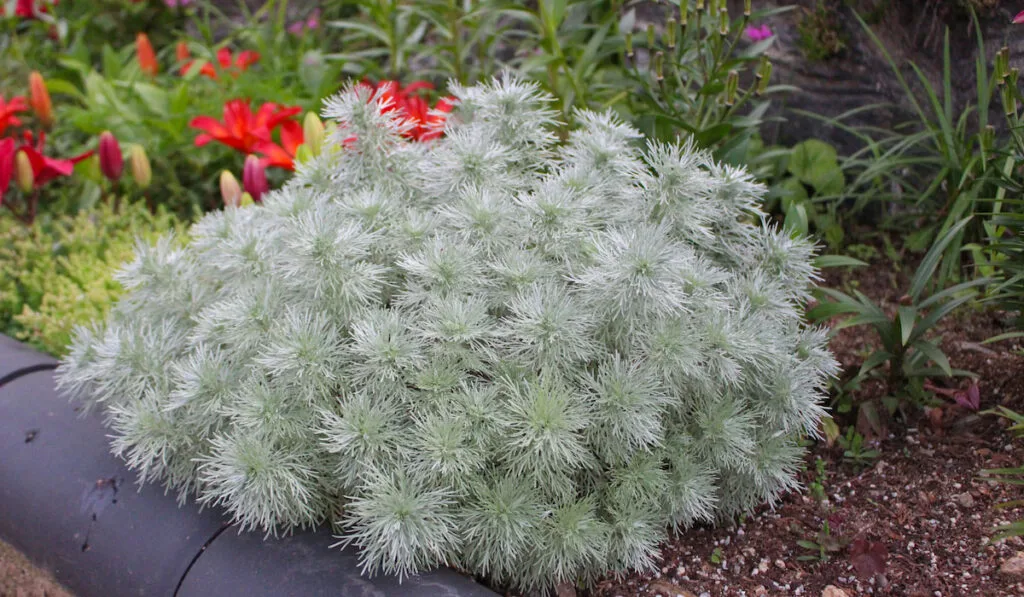
Artemisia is perfect if you’re looking for a plant that creates background interest in the landscape.
There are over 300 species of Artemisia that include perennials, annuals, and woody shrubs. The herbaceous perennials are mainly cultivated for garden use.
Artemisias have leaves in different shapes and can be covered with white hairs, giving them a silvery look.
It’s best to plant Artemisia in spring from nursery-grown plants.
You only need well-drained soil and full sun exposure to grow Artemisia.
A mature plant can grow up to 5 feet tall and 10 feet wide.
These plants are low maintenance and immune to most pests. You’ll only need to water the plant until its roots are established. Artemisia is drought tolerant and rarely requires supplemental watering.
However, you should note that certain species are highly toxic to animals and mildly toxic to humans.
5. Blue Avena Grass
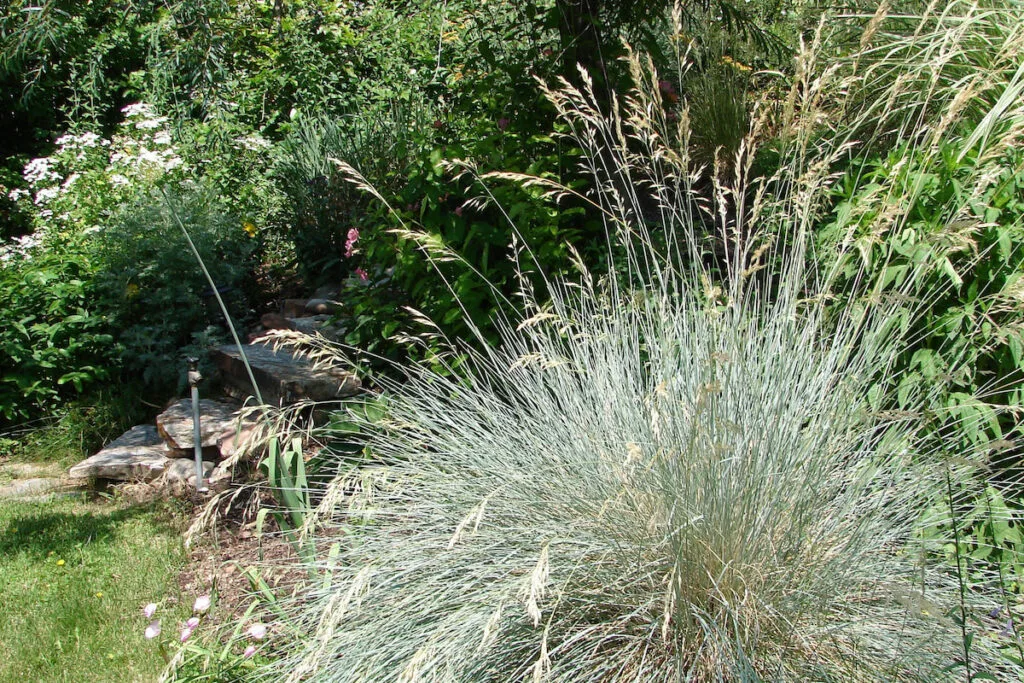
Blue Avena grass or blue oat grass is a beautiful addition to any landscape design.
This Colorado native blooms throughout the year, staying blue during the four seasons.
However, during summer and when exposed to full sun, blue Avena grass seed heads sprout, forming bright blue foliage that ages to a mild brown by mid-summer.
Although the drought-resistant plant thrives in the hot sun, it shouldn’t be grown in very arid climates.
This low-maintenance plant also needs well-drained soil but can grow in a container.
Growing blue Avena grass in the spring is best if you use seeds. Alternatively, you can get established clumps from a nursery.
6. Catmint
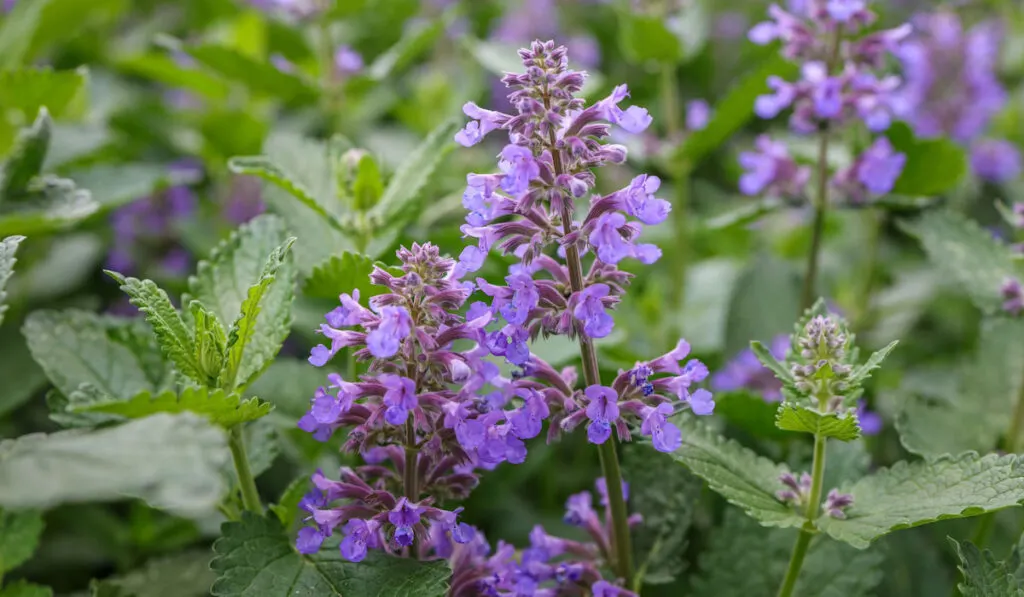
Catmint is a perennial herb that belongs to the mint family. The plant can have lavender-blue, pink, or white flowers.
Growing aromatic herbs is simple as they perform well in full sun exposure or partial shade with well-drained soil. The plant is also drought and heat tolerant, which makes it perfect for dry areas.
You can plant catmint for edging, which deters insects when paired with other vegetables.
When planting catmint, it’s best to give it enough space, at least two feet apart. Overcrowding the plants in a hot climate can lead to leaf spots or powdery mildew.
Catmint should be watered regularly until it’s established. Adding mulch also helps with moisture retention. You can promote more flowering by deadheading the old blooms.
7. Coral Bells

Coral bells, or Heuchera, are perfect for adding texture and color to any garden. These plants are also ideal for xeriscaping as they thrive in hot and dry conditions.
The perennial plant is available in different foliage colors like purple, red, bronze, and more. Their bell-shaped and tall blooms are also colorful and bloom from late spring to summer.
Growing coral bells requires filtered or shaded sun as they are native to wooded areas. These perennial plants have a low-growing habit, which makes them a great addition to the edges of natural gardens.
You can also grow coral bells with other types of perennial plants. They only need well-drained and fertile soil. Occasional watering is necessary, although plants in containers may need more water.
Deadheading spent blooms improve the plant’s overall appearance.
Propagation through cuttings or seeds should be done in spring.
8. Creeping Western Sand Cherry
The creeping western sand cherry is native to the Rocky Mountains.
Growing this perennial shrub transforms your garden through the changing seasons. You’ll love its white flowers and bright green leaves that turn orange, red, and burgundy in the fall.
Western sand cherry is great for xeriscaping as it can thrive in any soil condition or pH level.
Creeping western sand cherry thrives well in dry locations and in USDA hardiness zones 3-6. Full sunlight helps the western sand cherry produce beautiful blooms in spring and summer.
In the early stages, creeping western sand cherry needs occasional watering.
9. ‘Crimson Pygmy’ Barberry
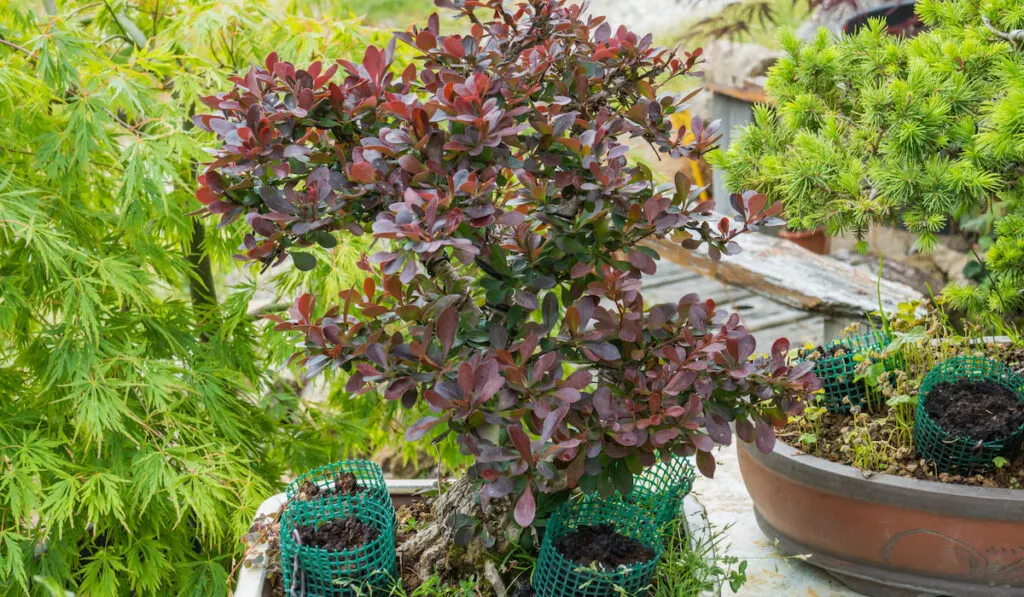
The ‘Crimson Pygmy’ barberry shrub is a dwarf ornamental shrub. It has deep, crimson-colored foliage, which acts as a great color contrast against green-leafed plants.
You’ll also find ‘Crimson Pygmy’ helpful if you’re looking for a deer and insect-resistant plant.
The shrub requires watering until established and slightly acidic, well-drained soil. Exposure to enough sun promotes the best foliage color.
It’s best to prune ‘Crimson Pygmy’ in late winter before the emergence of new growth. The deciduous shrub grows 2 feet tall and 3 feet wide at maturity.
Note that barberry can be invasive when it escapes the garden into unmanaged areas.
10. Fern-Bush
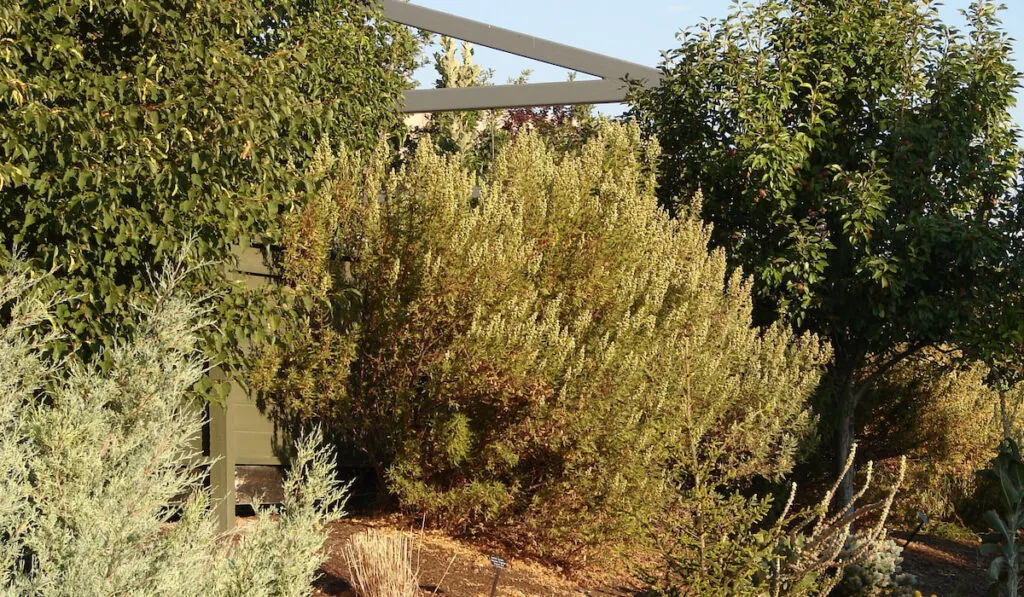
Fern-bush or desert sweet is a native shrub with white flower clusters. Its olive-green foliage and dried seed heads make this drought-resistant plant attractive in any garden.
Some people use fern bush to enhance the garden’s value as its flowers attract native bees.
There are different fern-bush varieties, each with specific requirements. Some thrive in clay soil, while others require sandy soil.
Nonetheless, most varieties do well in part or full sun and require a layer of mulch and occasional watering to establish better. You can plant fern-bush together with these other drought-tolerant plants: butterfly bush, Russian sage, and ‘Blue Mist’ spirea.
Pruning in early winter is recommended to encourage growth.
11. Festuca ‘Boulder Blue’
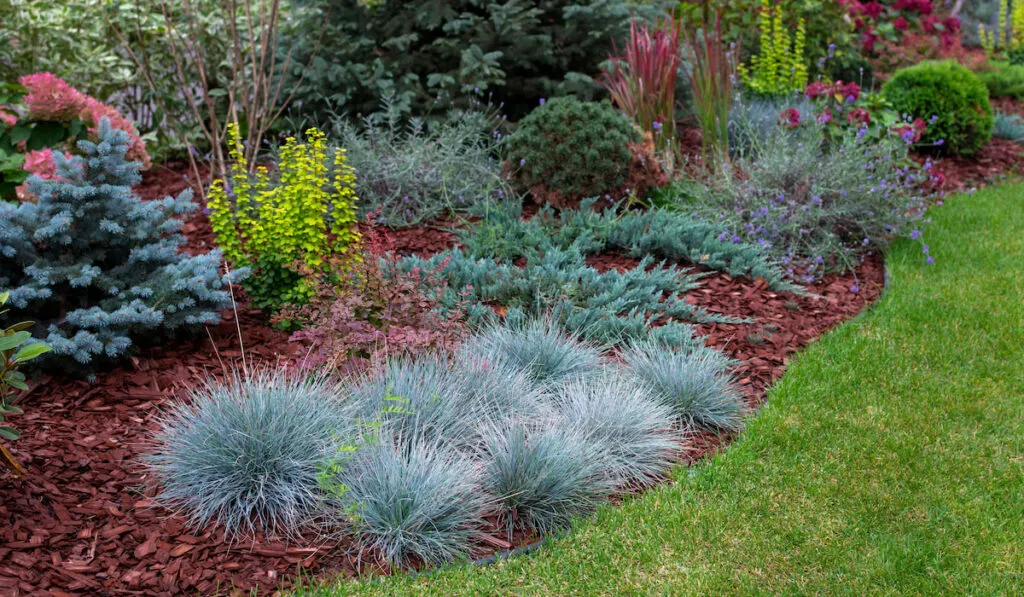
The Festuca ‘Boulder Blue,’ or blue fescue, has silvery-blue foliage and tan seed heads. It provides fantastic ground cover, thanks to its mounded form.
The perennial grass provides a delicate and fine texture to any garden. You can use it in woodland gardens, rock gardens, border edging, container planting, and general garden use.
Additionally, it thrives well in full sunlight and dry places. Well-drained and dry soil is preferred when growing Festuca ‘Boulder Blue’.
Although the plant has average moisture needs, you must water it occasionally when it’s very hot to ensure its bright blue-green color remains.
As a drought-resistant plant, Festuca ‘Boulder Blue’ is a perfect choice for xeriscapes.
Cut back the foliage in spring to give enough room for new blades and improve the plant’s overall appearance.
12. Fringed Sage
Fringed sage is another great xeriscaping plant common in Colorado’s mountain regions. The mounding plant has silvery-gray feathery leaves and erect stems.
Fringed sage gives off a gray or green appearance from afar. That provides a unique contrast when combined with other small plants.
Although the plant can grow in most places, it experiences stunted growth in alkaline soil.
Periodic shaping and pruning help to maintain the plant’s compact form.
13. Torch Lily

Torch lily, or red hot poker, belongs to the Liliaceae family. The plant gets its name from its characteristic flowers with a color and shape similar to flaming torches.
Torch lily grows from underground bulbs. It produces clusters of sword-like leaves that form a rosette with a stem in the middle.
Torch lilies bloom in early spring and summer, forming different shades of red, yellow, and orange. They thrive in full sun and well-drained soil. Some varieties can grow up to 4 feet tall.
Caring for torch lilies is easy.
In spring, you must trim the foliage base a few inches above the ground. That gives the plant a new start for growth.
These plants do not need a lot of water once growth has been established. Damp ground can cause the roots to rot and lead to fungal disease. Ensure the soil is porous and partially moist.
Although torch lilies can survive winter, it’s best to cover their leaves with a straw mat and layer the base with peat. That protects the plant from low temperatures.
14. Yucca
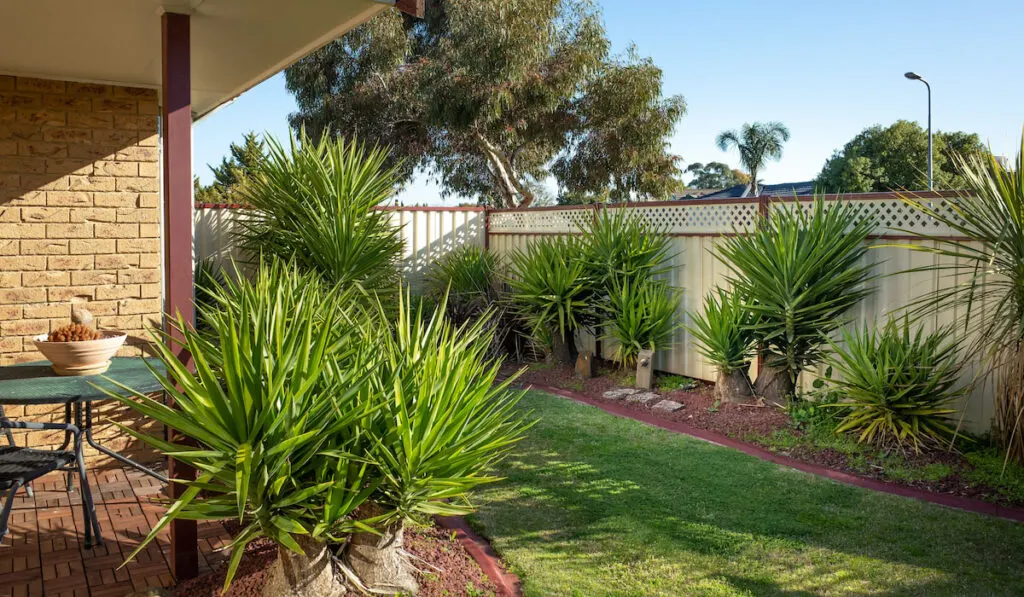
The yucca plant is an excellent addition to any landscape. It’s a perennial, evergreen shrub that grows well in full sun and in soil that drains well. It’s available in different varieties, with leaves ranging from blue-green to dark green.
When growing yuccas, leave enough space as a mature plant with an extensive root system can grow to 3 feet.
Keep the plant far from high-traffic arrears as its leaves are sharp and brushing against it can lead to cuts and bruises.
The plant thrives in full sun and can grow as tall as 3 meters or 10 feet tall.
Yucca is a southwestern native, which means it can also withstand low temperatures like 10°F.
Caring for yuccas is easy as you only need to cut the old leaves on a mature yucca plant to allow new leaves to grow. Ensure that you have gloves on as the plant has sharp leaves.
15. Yarrow
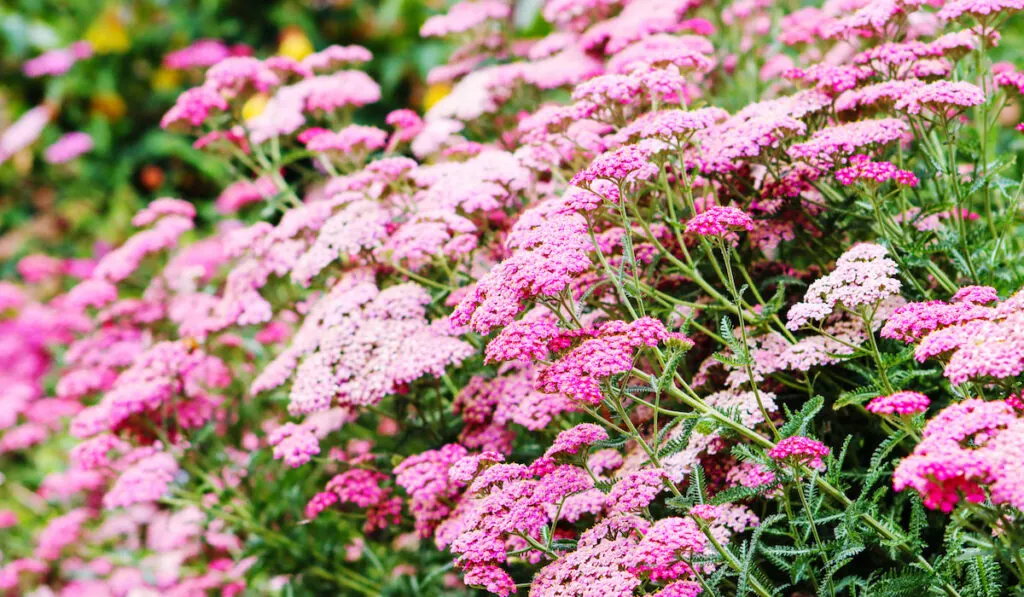
Achillea millefolium, or the yarrow plant, is an herbaceous perennial flowering plant.
Planting and maintaining yarrow is simple, as it needs little care. You don’t need to fertilize it, and watering is only necessary when there’s a severe drought.
Yarrow can be grown as an herb for its healing properties and as a decorative addition to your garden. The plant has yellow, red, white, and pink flowers.
Yarrow grows in USDA zones 3 to 9.
Despite being drought and pest-resistant, the yarrow plant tends to proliferate and can be invasive towards other plants. You need to be careful about how you space it out.
Yarrow is best planted in early summer or spring to prevent frost from damaging it.
16. Mexican Feather Grass
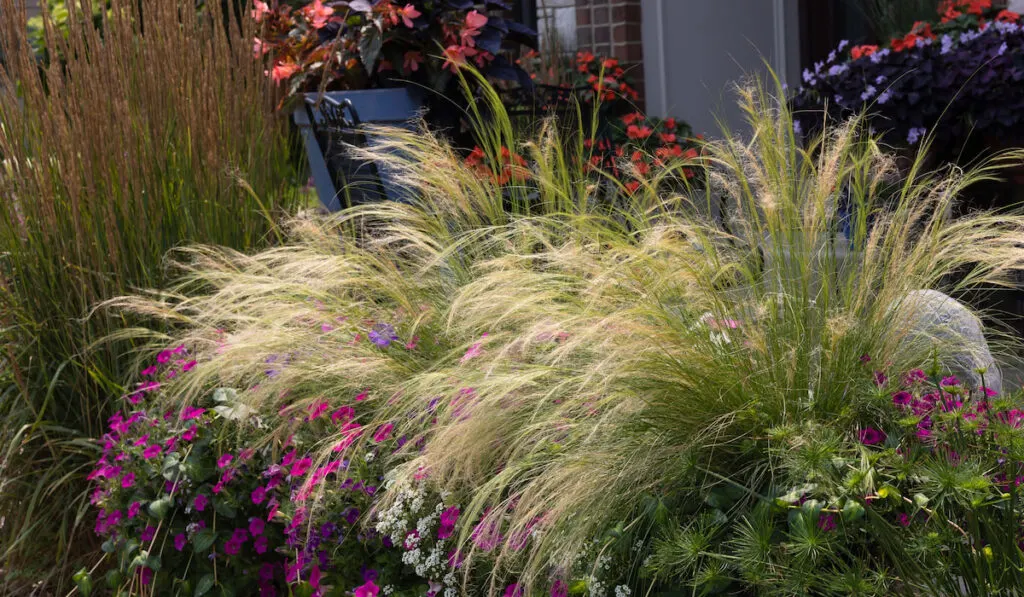
Mexican feather grass grows 2 feet tall. It has feathery flower panicles that provide enhanced beauty to the surrounding.
This ornamental grass blooms with full sunlight and loamy soil with excellent drainage.
Mexican feather grass is drought tolerant and won’t need frequent watering once established. Adding a compost layer promotes growth.
To keep the plant looking tidy, you’ll only need to trim overgrown stems and dead flowers.
Final Thoughts
Our list of the best xeriscape plants includes ornamental grasses, perennials, and deciduous and evergreen shrubs. You can choose to combine some with your regular plants to provide texture and color to your garden.
Resources
- https://www.gardeningknowhow.com/ornamental/foliage/yucca/caring-for-and-landscaping-with-yuccas-outdoors.htm
- https://www.gardenersworld.com/how-to/grow-plants/how-to-grow-agastache/
- https://www.gardenia.net/plant/fallugia-paradoxa
- https://www.ag.ndsu.edu/trees/handbook/th-3-45.pdf
- https://www.waterwiseplants.org/find-a-plant/fringed-sage/
- https://www.5280.com/2019/05/the-beginners-guide-to-xeriscape-in-denver/
- https://www.epicgardening.com/xeriscape-plants/
- https://www.thespruce.com/xeriscaping-plants-a-drought-resistant-approach-2130777
- https://resourcecentral.org/xeriscaping-in-colorado-a-step-by-step-guide/
- https://www.gardeningknowhow.com/ornamental/cacti-succulents/agave/growing-agave.htm
- https://www.waterwiseplants.org/find-a-plant/blue-fescue/
- https://www.waterwiseplants.org/find-a-plant/moonshine-yarrow/
- https://www.waterwiseplants.org/find-aplant/fernbush/
- https://plantselect.org/plantstories/fernbush-fantastic-fernbush/
